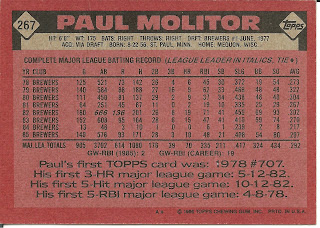Card thoughts: Scott looks like he’s going to fall over.
The player: Mike Scott was a mediocre pitcher with a great
fastball and no good secondary pitches. That is until he discovered the
split-finger fastball (and/or started scuffing the ball, as was rumored). A high draft pick by the Mets in 1976, Scott has some
success in the win column in the Minors (14 wins at Jackson in 1977; another 10 at Tidewater the
next year), but despite a blazing fastball he didn’t strike out a lot of guys.
This inconsistency plagued him the majors as well. In the
early 80s, the Mets were horrible, and Scott certainly wasn’t a savior for the
team, as he went 5-10 in 1981 and 7-13 in 1982, when he walked (60) almost as
many as he struck out (63).
The Mets gave up on Scott, and in what turned out to be a
terrible deal, traded him to the Astros for fourth outfielder Danny Heep. In
the more pitching friendly Astrodome, Scott had his first winning season, going
10-6 with a career low 3.72 ERA. But he regressed to the mean in 1984, sporting
a terrible .313 winning percentage (5 wins against 11 losses).
Clearly, Scott was at a career crossroads. Desperate for
help, he took the advice of teammate #197 Enos Cabell, who had seen what the Tigers pitching coach Roger
Craig had done for Jack Morris. The secret was the split-fingered fastball, and
as Craig was between coaching gigs in the winter of 1984, he taught it to
Scott.
The change in effectiveness was dramatic. Scott was one of
the more dominant National League pitchers when this card was issued, even surpassing
teammate #100 Nolan Ryan.
In the first of what would be five straight star campaigns, he went 18-8 with a
3.29 ERA. He still wasn’t striking out a lot of batters, more often getting
players to pound the ball into the ground.
That would all change in Scott’s Cy Young award winning 1986
campaign. Although he once again won 18 games, the improvement in his other
statistics was dramatic. He led the league in ERA with 2.22, and strikeouts
with 306 (in 275 innings pitched). Scott struck out an extraordinary 4 batters
for every one he walked. The most dramatic moment was when he pitched a
no-hitter against the Giants to clinch the division (radio call here).
Scott’s dominance continued in the playoffs he completely
dominated the Mets in Games 1 and 4, psyching them out by either scuffing or
pretending to scuff the ball. He did not get a chance to do it three times, as
the Mets won the pennant in 16 innings in Game 6.
Although Scott would never again have as dominant of a
season, he still won 16 games in 1987, 14 in 1988, and a league leading 20 in
1989. By this time, Scott was 34 and age and injuries took their toll. After
his 20 win season, he only pitched one more full season (9-13 in 205 innings in
1990), before retiring a few months into the 1991 campaign. His number has been
retired by the Astros.
While the split-finger fastball was one of the most popular
“new” pitches (although it developed out of the older forkball) in the 1980s,
it has rapidly gone out of favor, as many pitching coaches suspect it effects
the speed of the pitcher’s fastball over time. Only 13 pitchers today throw the
pitch regularly.
It's worth a short paragraph about the inning these guys both hit grand slams in. It was an 11-run ninth inning against two hapless Mets pitchers, Cal Koonce and Ron Taylor. 14 players came to the playte (both Wynn and Menke batted twice, with Wynn scoring first on Menke's grand slam, and later on his). There were 4 walks, 7 hits, and one passed ball. Nobody was left on base.
To add insult to injury, this was only the first game of a doubleheader, and Astros scored 11 more runs in the second game to sweep it.

















